The dishes that explain the history of South Africa’s Gold Rush City.
An introduction to Johannesburg’s history tends to begin with the story of two wandering prospectors quite literally stumbling on gold on the Witwatersrand (“ridge of white waters” in Afrikaans) region of what was then called the Transvaal (now Gauteng province, where Johannesburg is located) in 1886. This is where the world’s largest gold rush began, attracting European migrants who sought to make their claim on the newly discovered fortunes. The excavation of this seemingly endless supply of gold and diamonds required cheap labor, supplied by the African people already living in this region. The story of Johannesburg—known as Egoli (“city of gold”) in Zulu, the language and name of South Africa’s largest ethnic group—is that of a city forged by people from different walks of life seeking wealth and opportunity. It is from this layered history that Johannesburg’s rich and diverse culinary customs were born.
Pap
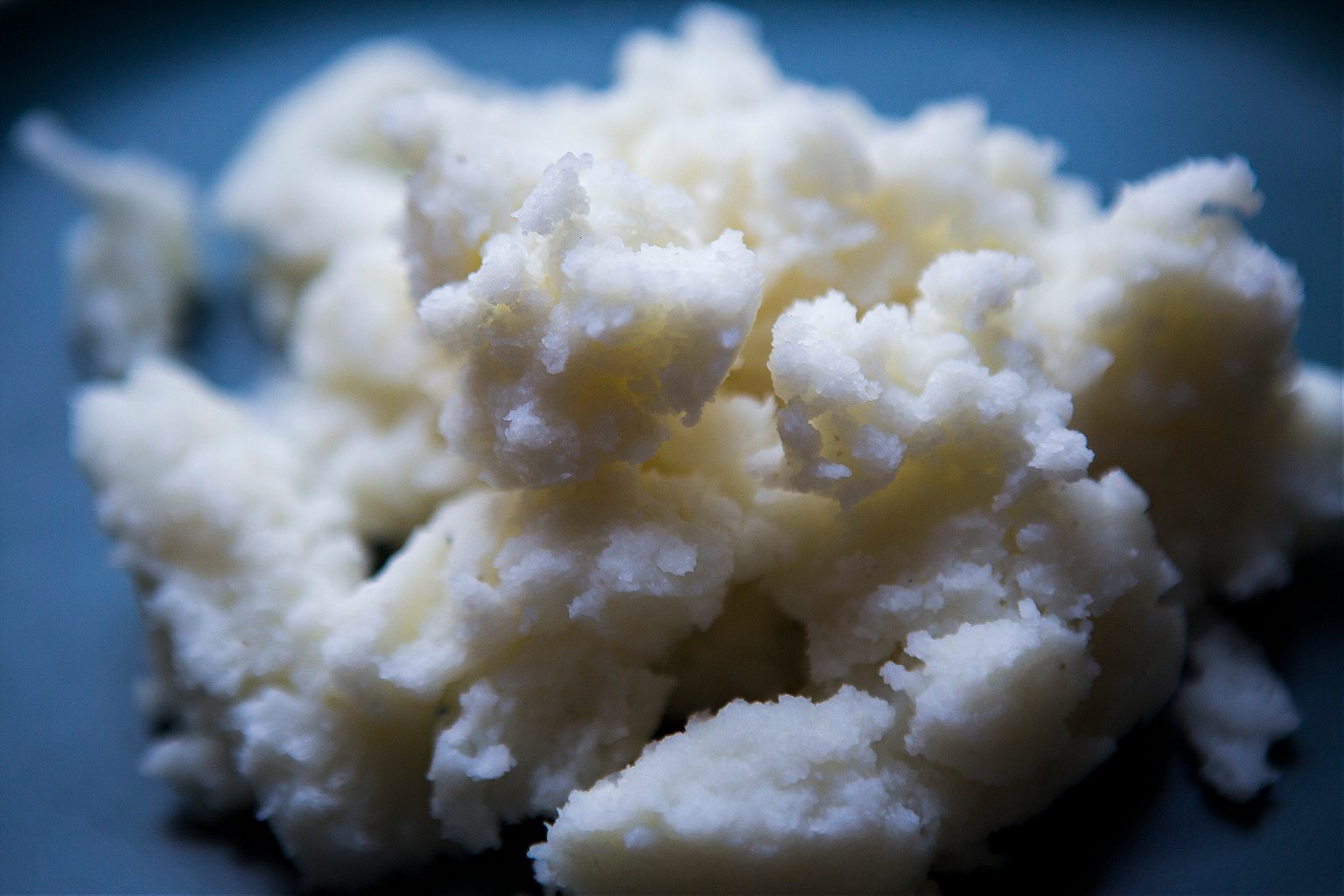
Pap, a softly cooked maize-meal, is a main staple in South African food history, especially in the interior plateau region where Johannesburg is located. Short for mieliepap, (maize porridge), it comes from the Bantu tribes (Nguni and Sotho-Tswana) that migrated from West Africa around 2,000 years ago and introduced agriculture to the south when it was mostly populated by hunters, foragers, and gatherers. The Bantu people cultivated a variety of crops such as maize, sorghum, millet, and vegetables, and kept herds of domestic cattle. Pap is served alongside anything from meaty stews to braai meat to creamy spinach. It was traditionally cooked for large gatherings in three-legged iron pots on an open fire. Today, it’s still the staple of choice for any dinner or gathering. Even fast-food retailers such as KFC have incorporated it into their menus here. Being able to make pap is an essential life skill in Johannesburg, and what constitutes as a good plate of pap varies with the individual’s taste in thickness and texture. Most Joburgers prefer it to be quite soft, using the palms of their hands to roll it up into little balls.
Pap is everywhere in Johannesburg, you don’t have to look for it. When visiting the local restaurants and shisanyamas—barbecues—around town, request your main meal with pap.
Vetkoek
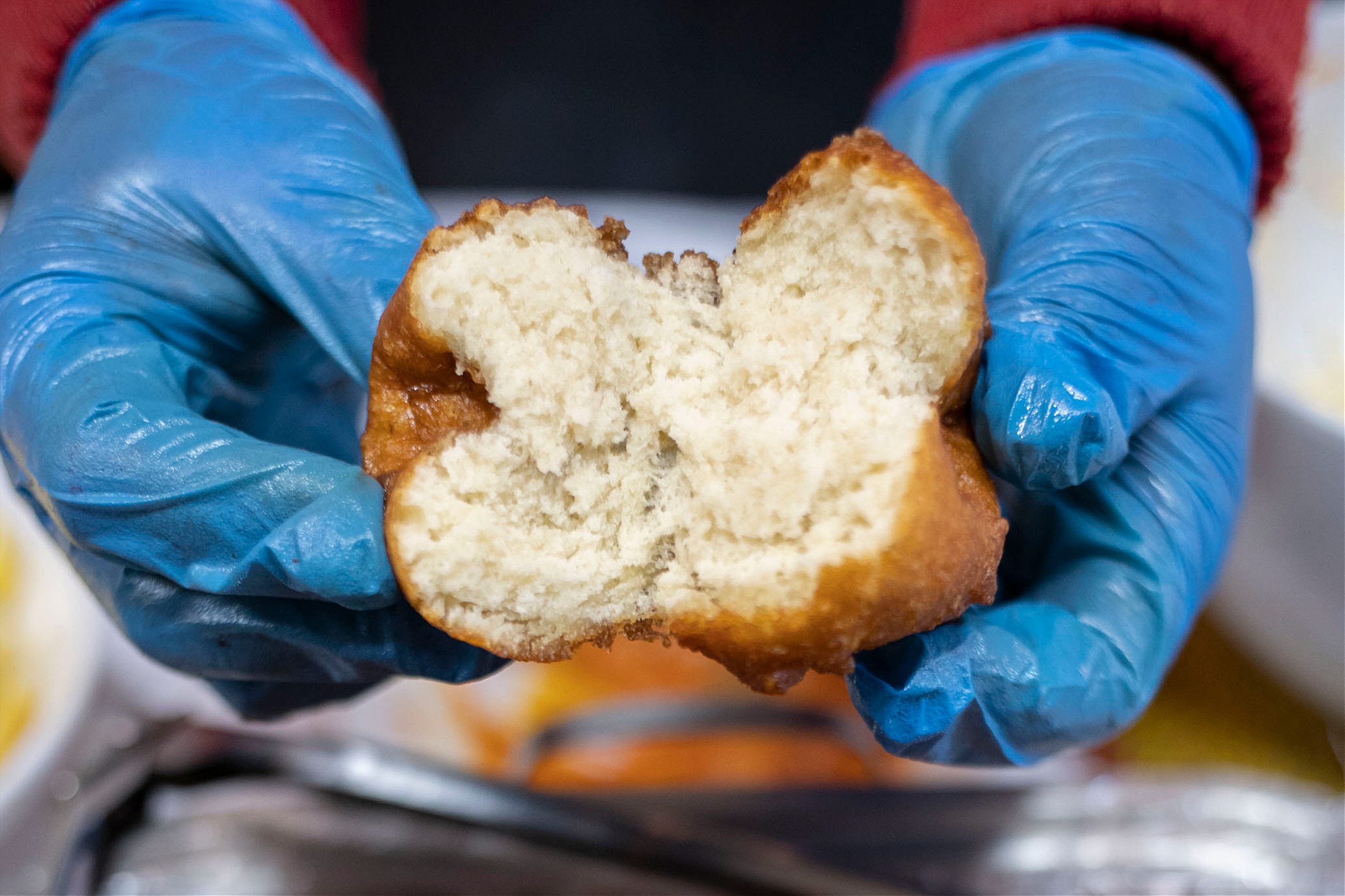
When the Dutch East India Company’s ships landed in Cape Town in 1652, the plan was simply to build a refreshment stop for ships sailing from Europe to Asia. (Although Portuguese explorers, searching for alternative trade routes to Asia when the growth of the Ottoman Empire disrupted overland trade, had spotted the Cape back in 1488.) The Dutch ended up occupying the territory on and off for 150 years—until the British took control—and together with the Germans and French Huguenots who settled in the Cape Colony, began to form an Afrikaner identity. It’s from this Dutch heritage that the Afrikaner people developed the deep-frying technique central to making the vetkoek (fat cake). A simple dough mixture of flour, yeast, sugar, and salt is left to rise before being divided into neat little balls. These are dunked into a frier to transform into something that looks very much like a doughnut—a crispy, golden crust exterior and a light, fluffy bread-like interior. The Vetkoek, which also known as amagwinya in South African townships—the historically segregated urban areas reserved for non-whites under apartheid—can be served plain, with syrup, or with a savory minced meat. In Johannesburg, amagwinya form a large share of the informal fast-food economy, commonly sold out of large bowls or buckets by mamas at taxi ranks and spaza shops (convenience stores) as a breakfast-on-the go, with the optional side of French polony (baloney sausage), atchar (pickled fruits), or Vienna sausages.
They can be found at these mom and pop shops littered all over central Johannesburg streets or if you’re in Soweto, visit Vuyo’s Restaurant in Vilakazi Street, where they shouldn’t set you back more than R20 each.
Braai/Shisanysama

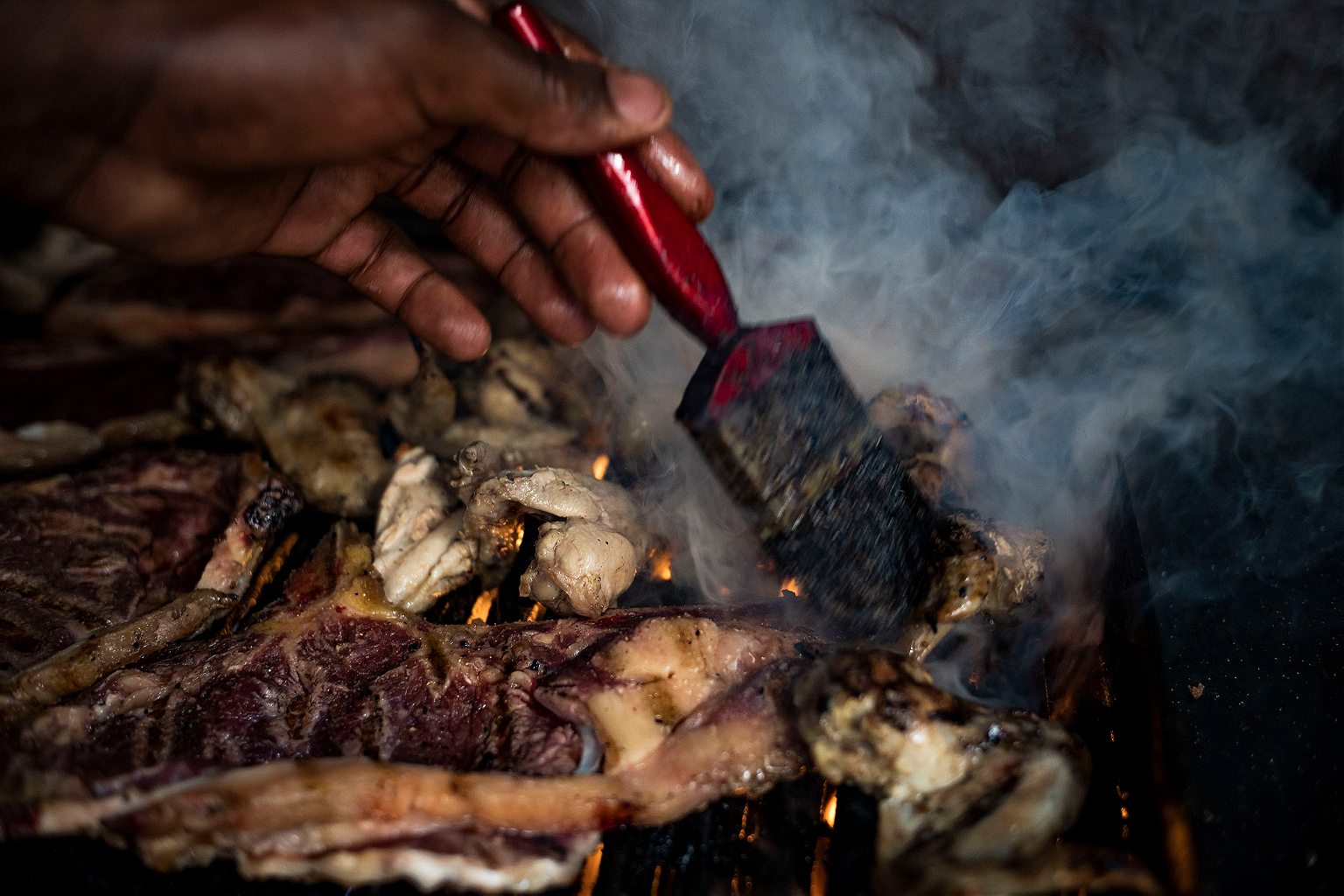
The Voortrekkers (Afrikaans for “pioneers”) were disgruntled Afrikaner farmers, also known as Boers, descended from the original settlers working for the Dutch East India Company. Unhappy with many aspects of British colonial rule (among other factors) they migrated east from the then-British occupied Cape Colony on the coast to the interior of South Africa in the 1830-40s. They travelled with ox-wagon and horses, which meant they had to pack light. To survive, the nomad farmers had to hunt, shoot, and roast meat on open fires in the open air, and so the culture of braaing (derived from the Dutch word for roast, “braden”) was born. The Bantu peoples who lived in these parts of South Africa at the time had also developed an appreciation for grilled meat. Where cattle were mainly used for the production of milk, they preferred to roast mutton, goat, or game. Another important protein supply for the Khoisan—a somewhat inadequate umbrella term for the non-Bantu tribes that were South Africa’s earliest inhabitants—in particular were grilled insects such as Mopani caterpillars, locusts, and termites. Today, standing around a fire and preparing grilled meat is a unifying part of Johannesburg culture, enjoyed by people across different ethnic backgrounds. When you invite friends over for beers, braaing meat is almost inevitable.
There are numerous braai meat spots in town, but my personal favourite is The Busy Corner in Thembisa, also more formally known as Imbizo Shisanyama. They always serve perfectly succulent braai meat and pap, with friendly service.
Biltong
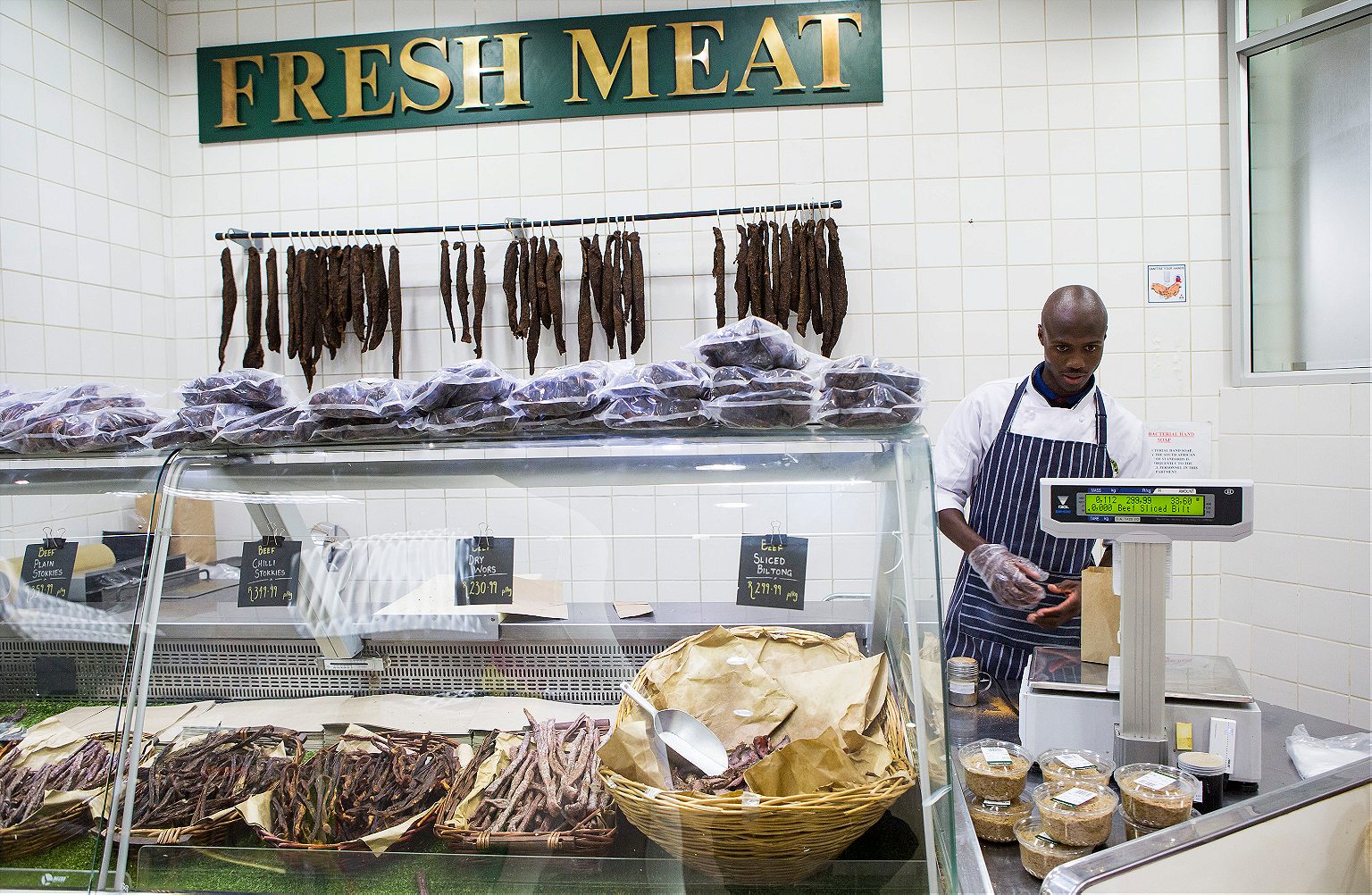

Long before iceboxes and refrigerators were invented, the Khoisan and Bantu people of South africa were curing and preserving game meat. It was common practice to eat the more perishable meat organs such as liver and kidney first, and then cure, dry, and cut the bigger cuts of meat to be enjoyed later. The Voortrekker adopted some of these practices and incorporated the spices they got from the Javanese slaves—such as coriander, cloves, and nutmeg—into the process. Today this delicacy is called biltong, and as an intrinsic part of South African culture, is found everywhere from gas stations to upscale restaurants. You can get it in sticks, cubes, thin slices, or strips, with fat or no fat. The best biltong is usually sold in brown paper bags at local butcheries or meat markets in quiet Afrikaner neighborhoods.
My favorite source is the biltong an old-style grocery supermarket in Illovo, called Thrupps Food and Groceries. But many brands, such as Joubert and Monty, have biltong kiosks in shopping malls all over Johannesburg.
Chakalaka
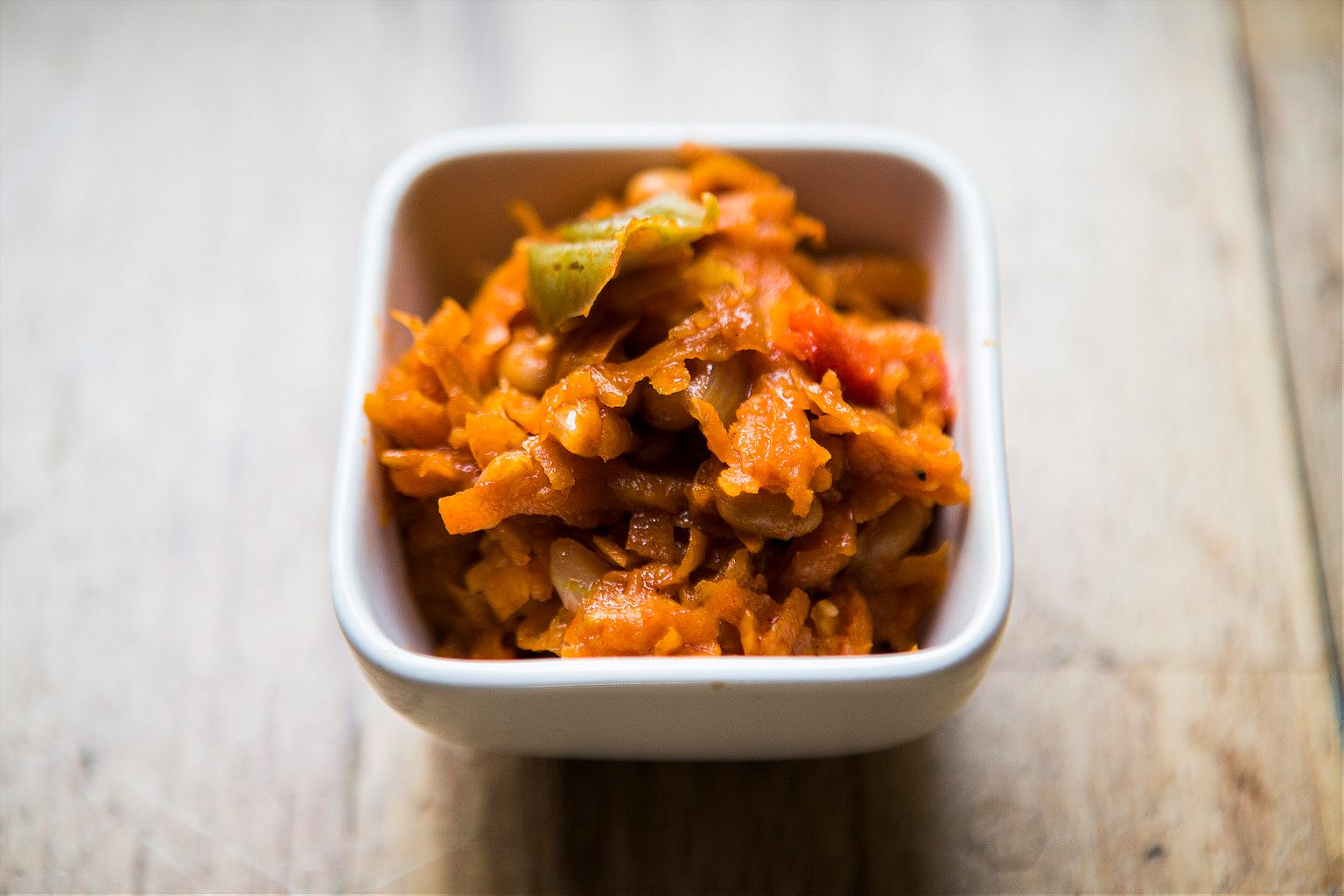
Where pap is the staple for any dinner or braai in Johannesburg, chakalaka is the mandatory side dish. This spicy salad (in South Africa, we are generous with our definition of salad) is primarily a mixture of sauteed canned beans, grated carrots, peppers, tomatoes, garlic, and spices. Chakalaka is likely to have been invented in the Johannesburg townships or in the mines around Johannesburg, by immigrants from Mozambique who came to work in the mines in the 19th century and brought with them their Portuguese culinary influences (another is piri-piri chicken). The story goes that after their shifts, the mineworkers would mix tinned produce—often beans—with everything they had (including chili) into a pot, and let it simmer to create this Portuguese-influenced dish.
Chakalaka will elevate any plate of meat, vegetables, or starch from blandness. As a result, there are many different variations, and secret family recipes are passed down through generations. If you’re a lazy millennial like I am, you’re more likely to buy it off the shelves and tweak the flavors by adding your own spices and condiments.
As is the case with pap, all shisanyamas in Johannesburg will serve a good chakalaka. You will be sure to get the real experience at Sakhumzi’s Restaurant on Vilakazi street, Soweto.
Melktert
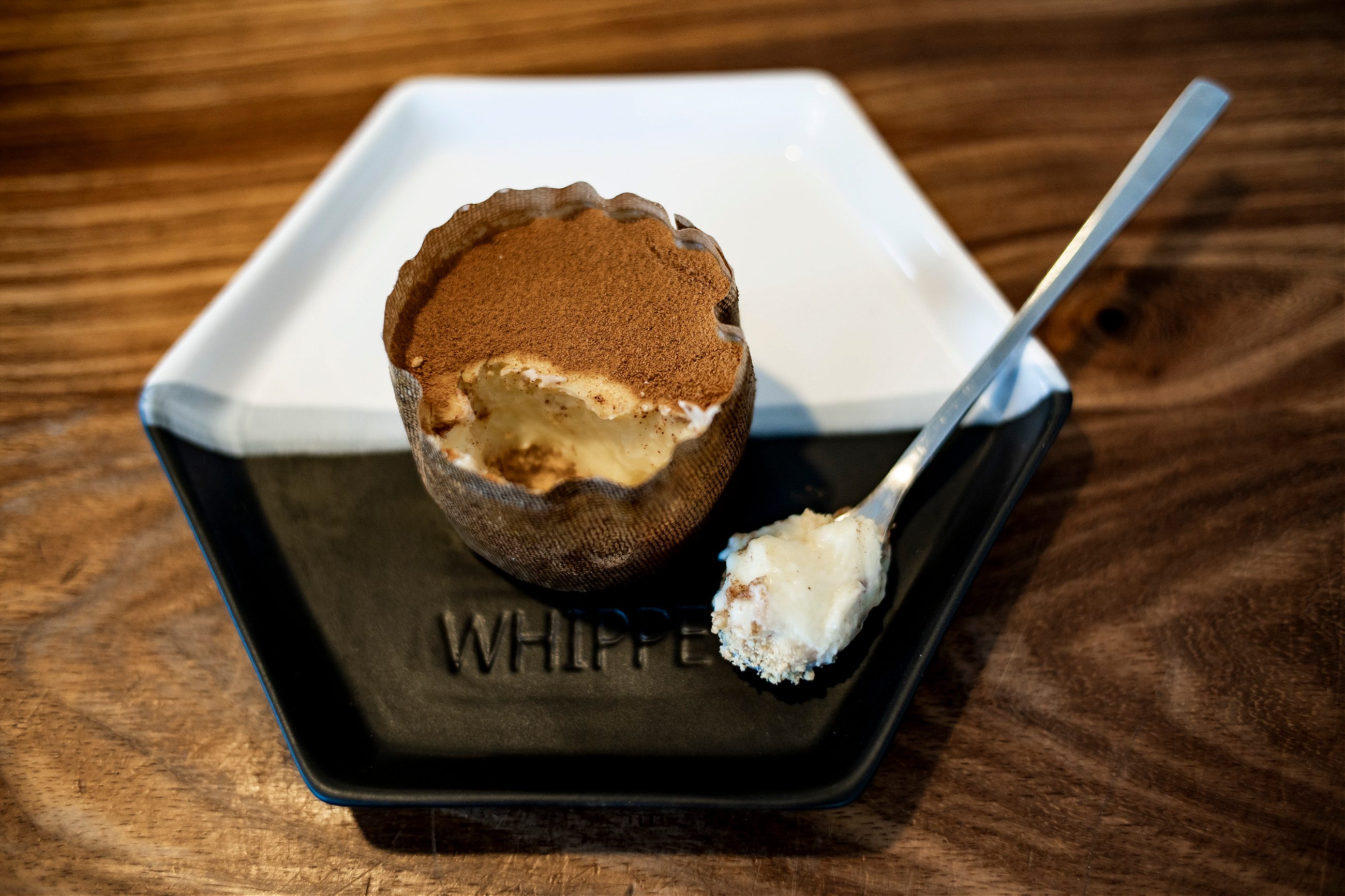
The melktert (milk tart) is a delicious baked-egg custard tart made of a fluffy mixture of eggs, milk, and sugar, sometimes thickened with flour, filled into a light, crunchy and sweet pastry case. Topped with a generous dusting of cinnamon, the melktert is perfect when it’s given time to settle and cool in the fridge. Its Cape Dutch origins can possibly be attributed to the Dutch mattentaart: a round tangy cake with cheesecake consistency set inside a puff pastry. The cinnamon is an ode to the Javanese slaves that were brought to the Cape of South Africa by the Dutch East India Company. It’s often eaten as a dessert, or as a treat with tea—by all communities in South Africa.
The best melktert in town, for me, comes from The Whippet, in the quiet, fashionable suburb of Linden. Their tartlets have the perfect balance of sweetness, cream, and crunch. As per tradition in Johannesburg, you will also find melktert being sold at almost any food market. I personally enjoy the Fourways Farmer’s Market.
Atchar
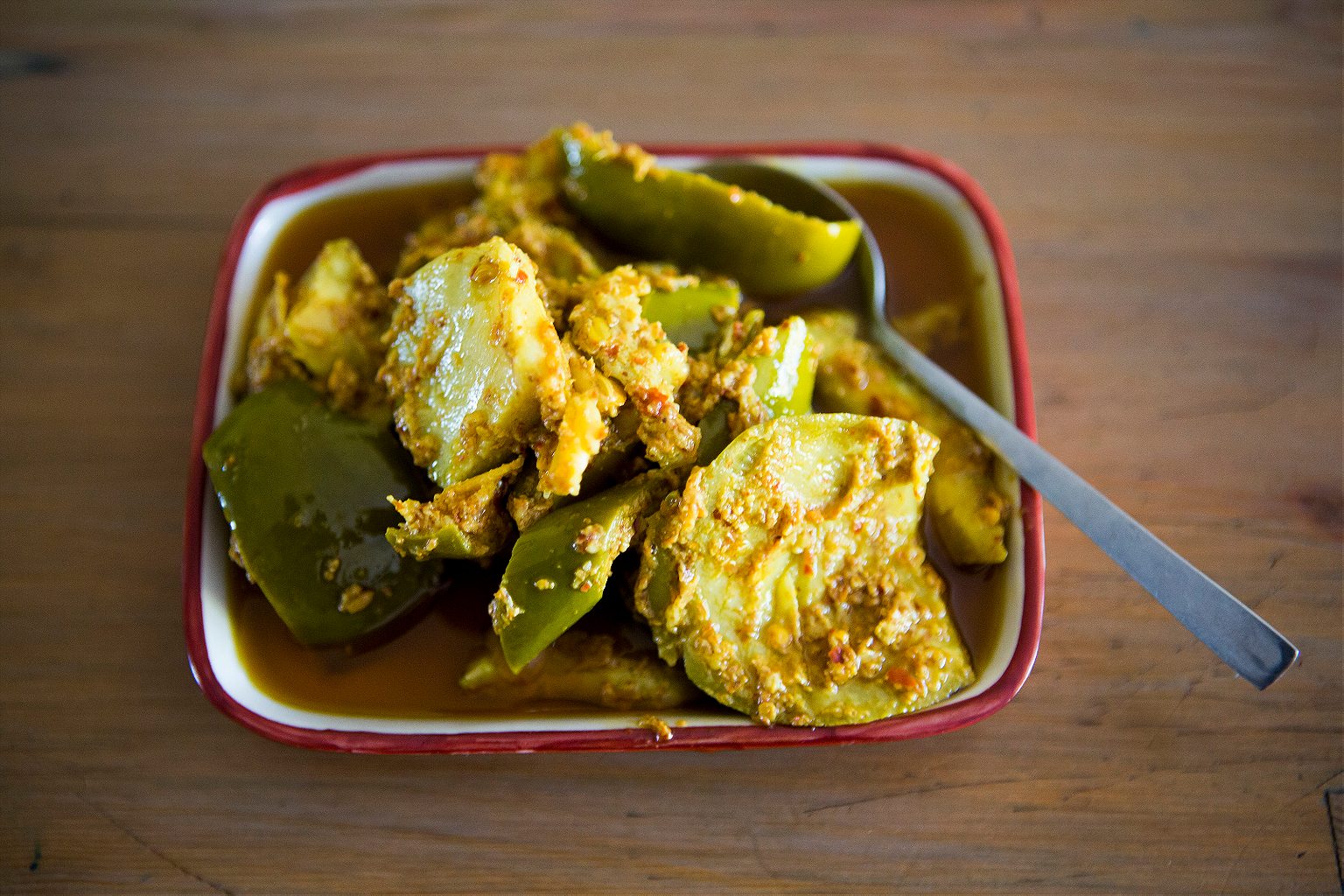
South Koreans have kimchi, the Germans have sauerkraut, and Nordic folk have pickled herring; in Johannesburg we have atchar. The story of this tangy relish dates back to the indentured Indian laborers that the British brought to South Africa in the mid-19th century to work in the sugarcane fields in the Colony of Natal, in the eastern part of South Africa, who brought “achar” (“pickle” in Hindi) from India. There are many variations of South Asian achars (in South Africa it is usually spelled atchar), made with pickled vegetables or fruits in brine, but in South Africa the most popular variant is made with a blend of unripe green mangoes and chillies. It usually comes as a condiment to dishes such as braais, stews, curries, or even just a slice of white bread.
There’s a wide selection of atchar brands at South African retailers, but it seems that the most trusted kind is the oily “no name” variety that is sold by street vendors, packed in little plastic tubs that don’t have a use-by date. Many a people have paid their way through college or built small franchises from the production and sale of their unique atchar recipes. Finding the one that suits your particular tastes generally works by referral. You can also shop for it online at Jabu Atchar or The Achaar King.
Kota
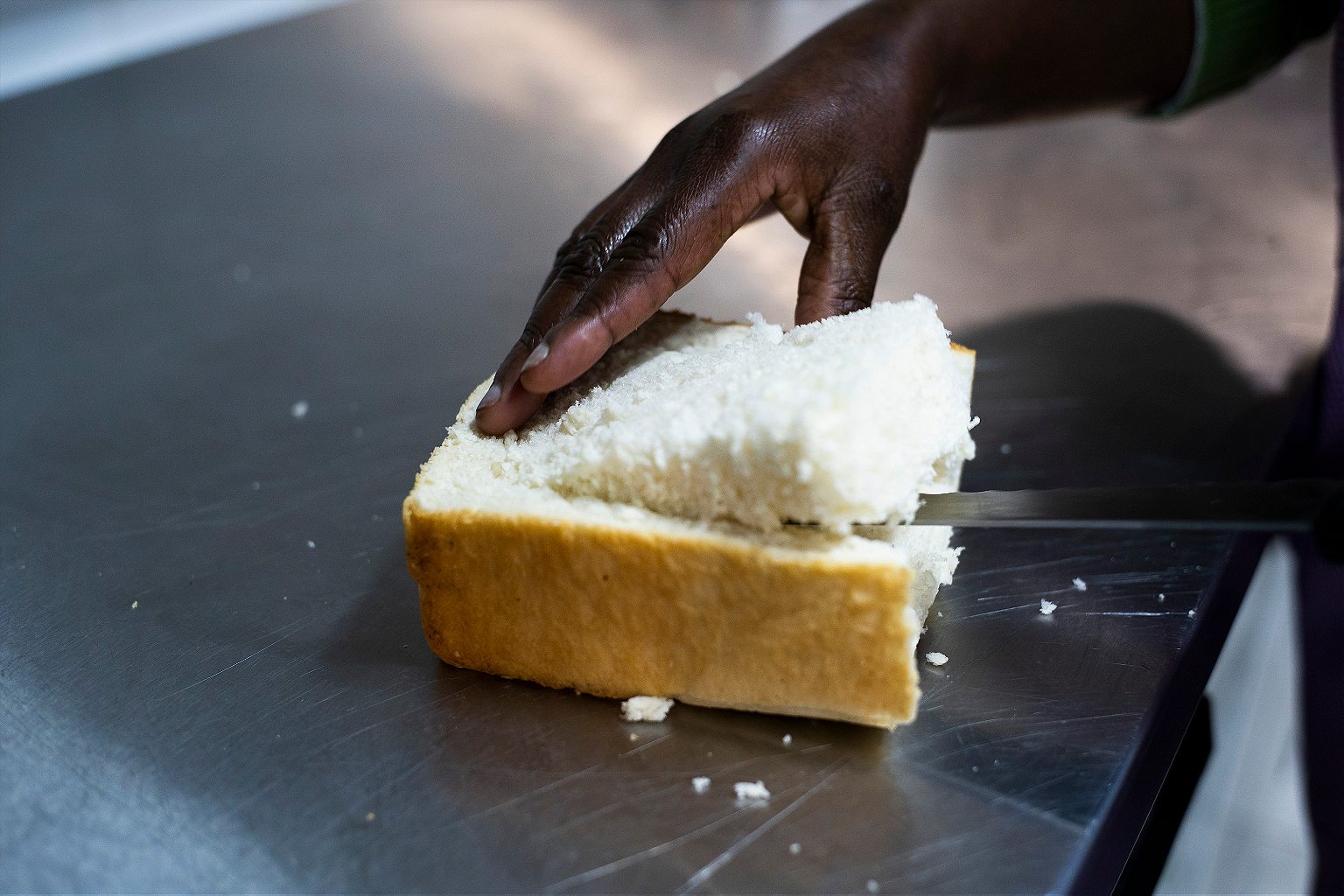
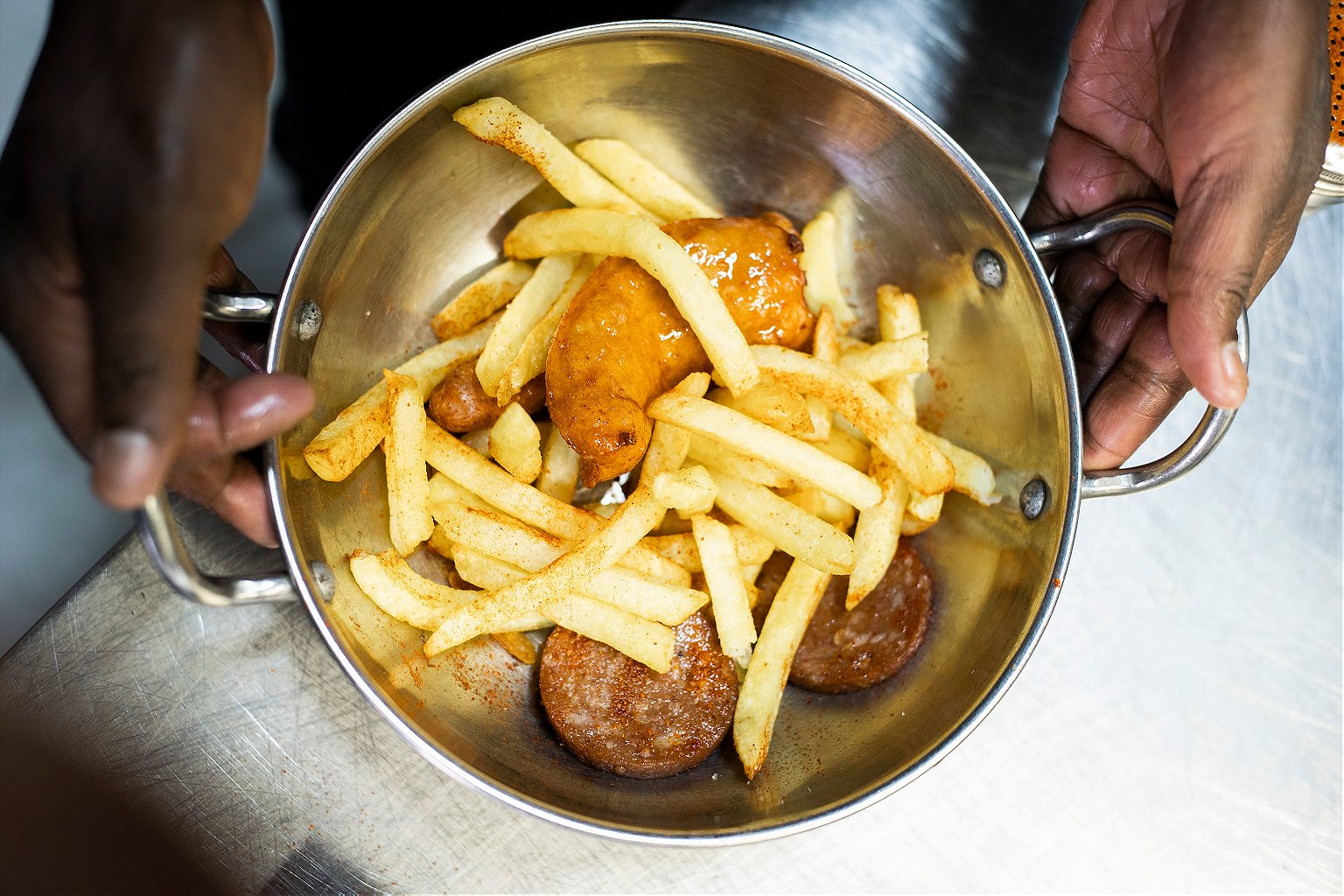
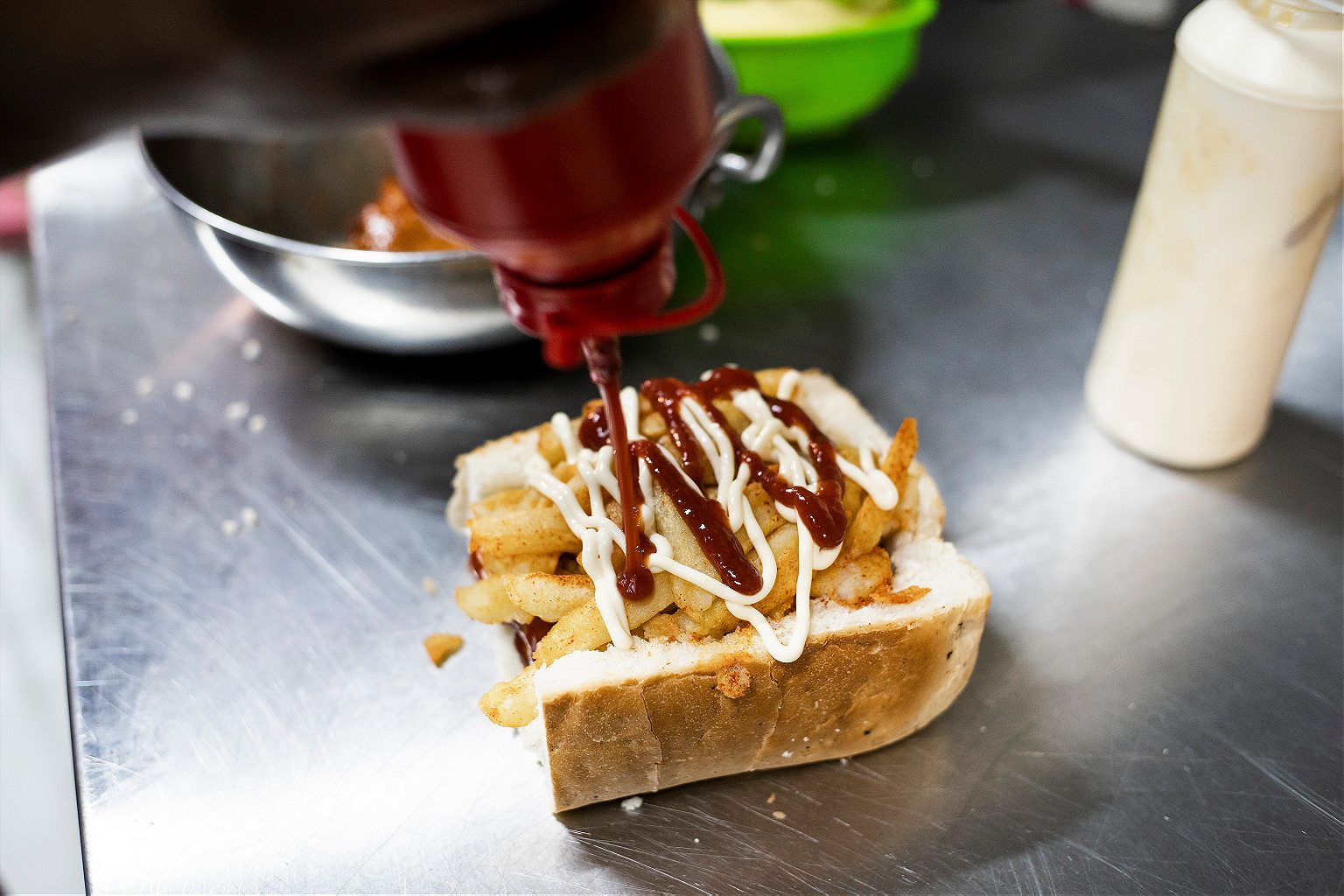
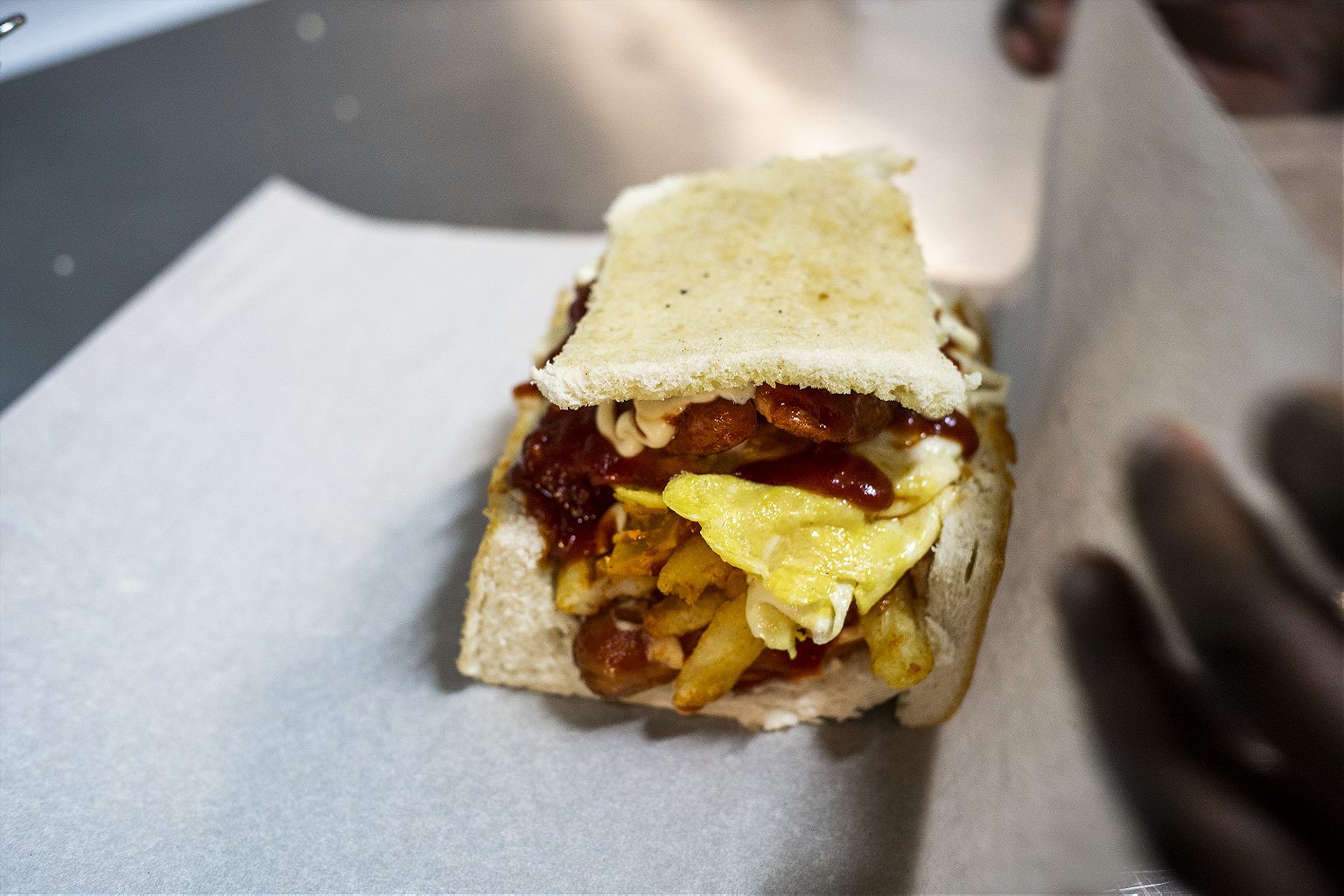
The kota (derived from the word “quarter”) is quarter-loaf of bread, hollowed out and stuffed with anything and everything from French fries, polony (similar to baloney) cheese, atchar, etc. It’s impossible to pinpoint the exact origins of the kota, but it is popular in townships around Johannesburg and in Gauteng province. The kota is the same family as the Cape Town Gatsby sandwich: a foot-long roll usually layered with similar ingredients. It also bears some resemblance to the Durban Bunny Chow—also a half or quarter loaf of hollowed bread but filled with hot and spicy meat or vegetable curry—thought to have originated with the Indian-descended communities in and around Durban. What is clear is that the kota is a classic Jo’burg take-away meal: a resourceful solution for people always in a rush to get somewhere where money can be made, filled with flavors and textures absorbed from different cultures.
Try the famous Designer Kota, served with a side of chakalaka or atchar at the Nkukhu Box, in Orlando East in Soweto.
Malva Pudding

If you could name one dessert that is enjoyed across racial and cultural boundary lines in South Africa, it would be Malva pudding. This national treasure is a cake-like pudding made with sugar, eggs, flour, butter, and apricot jam, and then soaked in a hot butter-cream sauce to serve. Malva pudding is often eaten after Sunday lunch in South Africa, and can be enjoyed with custard, ice cream, or whipped cream. No two recipes are exactly alike, as with different variations of stodginess and sweetness. Although the origins of Malva remain unclear (there are several theories, including that it was named after a woman named Malva, or after Madeiran Malvasia wine). It’s similar to other baked goods with pour-over-sauce-type puddings such as British bread and butter pudding and the spiced Cape brandy pudding. I don’t think I have ever had a bad malva pudding in my life, and even the store-bought kinds are really good.
On any given Sunday, after a roast ( borrowed from the British of having a formal lunch with family after Church on a Sunday) , I’ll have the Woolworths Food Malva, popped in the oven for 20 minutes and drenched in store-bought fresh vanilla-bean custard. For something more boozy, try the Amarula Malva pudding served at Lucky Bean in Melville.
Skopas Popcorn
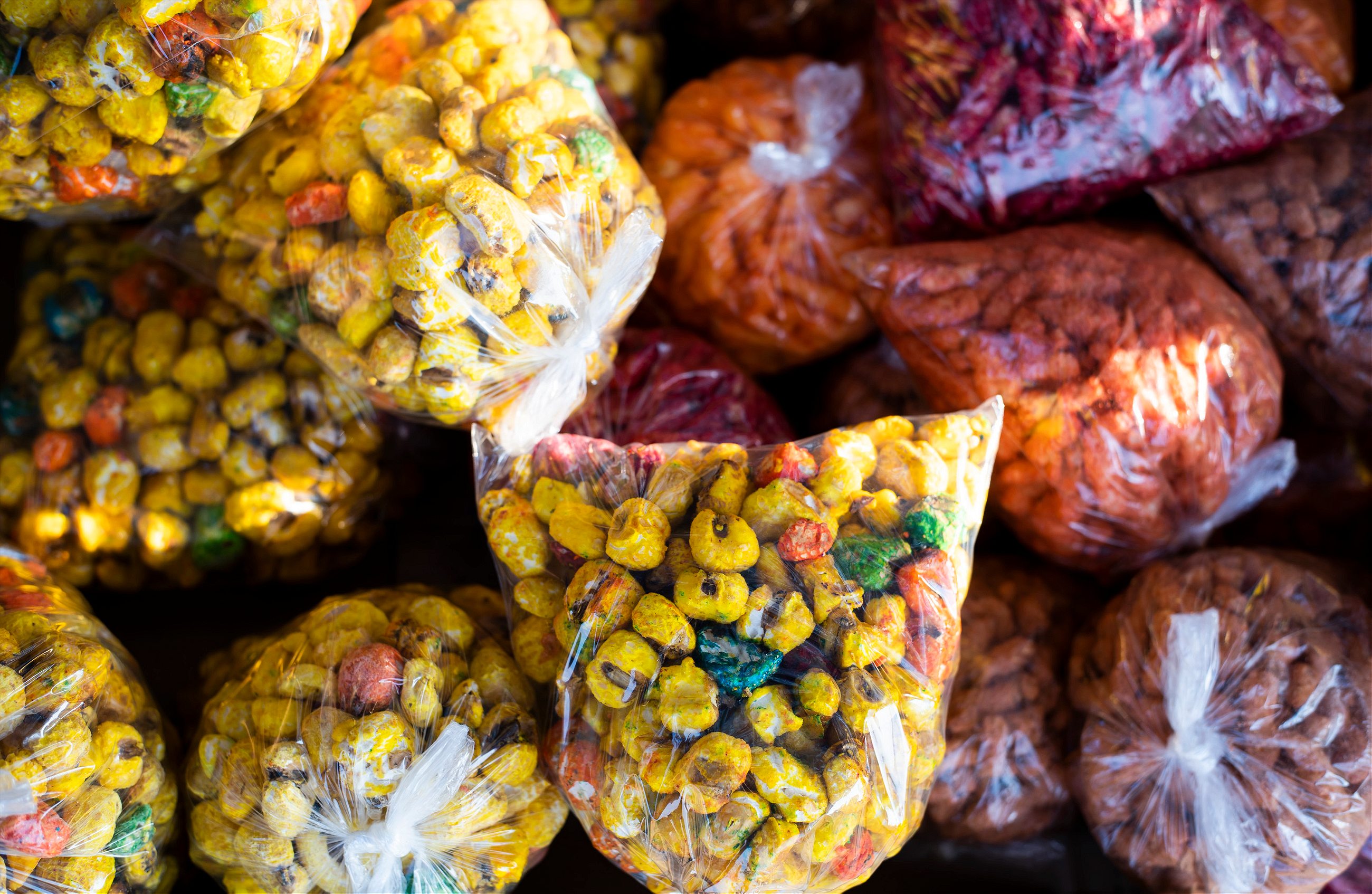
Skopas is a Johannesburg brand of puffed corn sold all over the city streets: taxi ranks, spaza shops, and vendor stalls. Much like the bright lights of the city of gold, the outward appearance of this bright, candy-colored snack deceives. One might expect it to taste like sugary sweet frosted-cereal pops, but it tastes more like stale, unseasoned popcorn. Still, Di Skopas, also known as di Kip Kip, are a popular “poor man’s snack,” keeping hustlers, mamas carrying babies on their backs, and commuting schoolchildren satiated at only one or two rands per pack. No one knows where they come from or how they came to be a central part of Jo’burg street culture, but the corn is usually procured from Indian or Chinese wholesale warehouses, where they come packed in clear plastic bags, stacked between cell phone chargers and aisles of synthetic hair.
It’s hard not to find them at the stalls in Bree Taxi Rank or walking down the Johannesburg CBD streets. Alternatively, get them at the source at Jumbo Cash and Carry in Crown Mines.






